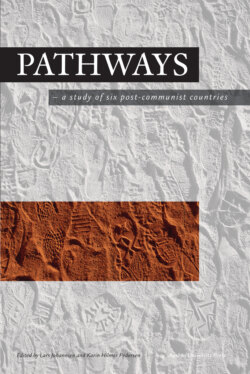Читать книгу Pathways - Группа авторов - Страница 11
На сайте Литреса книга снята с продажи.
Who to include and who to exclude?
ОглавлениеNation building, as a process distinct from state building, is the building block that completes the quadruple transformation process (Lewis 2004), and when Schmitter and Karl (1994) ask ‘how far east should [transitologists] attempt to go?’, Kuzio (2001, 169) replies indirectly by arguing that transitologists did not ‘go far enough’ in their efforts to develop a framework capable of distinguishing between state building and the national question as two separate and conceptually different processes. In the post-communist patchwork of nationalities and minorities, anti-discriminatory policies had the potential to provoke dissatisfaction in the ‘titular’ population if they felt the ‘new’ state did not pay sufficient attention to their needs. So when the post-communist states had to change entire political and economic systems and rebuild their states, they were challenged by the fourth issue of nation building, compelling them to define who should be the ‘people’ constituting the political community (Kuzio, 2001).
The challenge of nation building emerges again because the states were founded in accordance with the Westphalian notion of one nation (Brubaker, 1996) through which it is decided who belongs to the state (inclusion) and who does not (exclusion). Defining the nation is far from an objective exercise, however. As argued by Benedict Anderson (1983), a nation reflects the way in which people within the borders of a given territory imagine belongingness to the political community. It is argued that imagined belongingness can be formed in either of two ways. First, belongingness can be established on the principle of citizenship, thus according every citizen within the territory equal rights and obligations. Second, belongingness can be built on a sense of shared cultural or ethnic characteristics, common language, tradition or history. In either case the image of a nation limits and thus stands in contrast to the images of other nations.
The distinction between a civic and an ethnic core of a nation was discussed at length after Brubaker’s seminal book. According to Kuzio (2001), however, this implies that it should be possible to identify states empirically based on civic principles alone. But this is not the case. In contrast, he argues that all civic states have ethno-cultural cores, but they emphasise their ethno-cultural cores to varying degrees, and thus, with different implications for choices in the three other transformation areas.
Faced with the challenge of defining the nation, the elites often appealed to the nationalism of the ‘titular’ population as a strategy to consolidate their own power (Linz & Stepan, 1996). Besides, nationalism thrived well in these countries as it was commensurate with the Soviet legacy that based citizenship in the tradition of Volk, blood, narod and race (Crawford & Lijphart 1995; Bunce 1995b).
The issue of nation building may be played out in an exclusive and possibly hostile way, or it may be inclusive and pragmatic. Contrast, for example, the Kazakhstani rhetoric of inclusion and a ‘Kazakhstani’ state with the ethnic conflicts in Georgia. But even though the question of nation building was more apparent in countries further to the east, as the examples of Kazakhstan and Georgia show, it was not absent in Central and Eastern Europe. Looking beyond the countries considered in this book, Slovakia is a prime example of state formation being a nationalising project (Tesser 2003; Pridham 2002). Furthermore, Latvia and Estonia were criticised for building an ‘ethnocracy’ when they excluded Soviet-era immigrants from political participation in the early days of transition (Linz & Stepan 1996). Even Hungary had to face the question of nation building when the Antall government in the early 1990s had to deal with an irredentist claim that the borders with neighbouring Slovakia and Romania should be reconsidered (see, for example, Vachaudova 2005).
The consequences of early decisions about nationhood are evident. The Estonian de facto exclusion of the Russian population from participating in early elections and in privatisation schemes created a momentum that enabled the titular Estonians to (re-)capture the economy and state apparatus. In contrast, the undetermined nation building in Georgia placed the country between ethnic and civil wars, delaying large-scale privatisation and administrative reconstruction. Defining the nation never really became an issue in Poland despite the existence of external territories with large groups of ethnic Poles in Lithuania and Ukraine. Nationality being a ‘non-issue’, the political struggle has concentrated on building and re-building institutions.
In more general terms, and following Rustow (1970), a nation is consolidated when the community is taken for granted and is above normal politics. Nation building is thus distinct from state building in the sense that it refers to a community based on shared or imagined values rather than on the state. However, nation building and state building are also matters of practice (Kopecky & Mudde 2000). Nationalist movements not only functioned as catalysts for bringing down the inner Soviet empire, as the popular movements in the Baltic states and elsewhere showed (Tuminez 2003; Bunce 2005). Part of the state-building process involves the creation of a positive identification, and an effective state requires the existence of an established and agreed political community (Rustow 1970; Kubicek 2000). The link between nation building and the other transformation areas thereby highlights the way in which decisions on inclusion/exclusion may impact the functioning of democracy, redistribution of wealth in the privatisation process, and rebuilding state administrative capacity.
